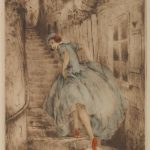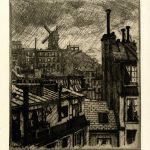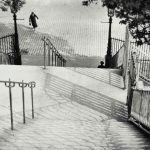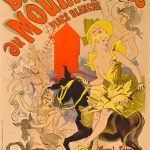During the Belle Époque from 1872 to 1914, many notable artists lived and worked in Montmartre, where the rents were low and the atmosphere congenial. Pierre-Auguste Renoir rented space at 12 rue Cortot in 1876 to paint Bal du moulin de la Galette, showing a dance at Montmartre on a Sunday afternoon. Maurice Utrillo lived at the same address from 1906 to 1914, and Raoul Dufy shared an atelier there from 1901 to 1911. The building is now the Musée de Montmartre. Pablo Picasso, Amedeo Modigliani and other artists lived and worked in a building called Le Bateau-Lavoir during the years 1904–1909, where Picasso painted one of his most important masterpieces, Les Demoiselles d’Avignon. Several noted composers, including Erik Satie, lived in the neighbourhood. Most of the artists left after the outbreak of World War I, the majority of them going to the Montparnasse quarter.
Artists’ associations such as Les Nabis and the Incohérents were formed and individuals including Vincent van Gogh, Pierre Brissaud, Alfred Jarry, Jacques Villon, Raymond Duchamp-Villon, Henri Matisse, André Derain, Suzanne Valadon, Edgar Degas, Henri de Toulouse-Lautrec, Théophile Steinlen, and African-American expatriates such as Langston Hughes worked in Montmartre and drew some of their inspiration from the area.
The last of the bohemian Montmartre artists was Gen Paul (1895–1975), born in Montmartre and a friend of Utrillo. Paul’s calligraphic expressionist lithographs, sometimes memorializing picturesque Montmartre itself, owe a lot to Raoul Dufy.
Among the last of the neighborhood’s bohemian gathering places was R-26, an artistic salon frequented by Josephine Baker, Le Corbusier and Django Reinhardt. Its name was immortalized by Reinhardt in his 1947 tribute song “R. vingt-six. Reference: Wikipedia
Brassaï 1899-1984 ‘BIJOU Á PARIS’ (MONTMARTRE) signed and with edition ‘4/30′ in ink in the margin, title, date, and number in ink and with the photographer’s ’81, Faubourg St.-Jacques, PARIS-XIV’ studio and reproduction rights stamps on the reverse, 1932, printed later (The Secret Paris of the ’30s, unpaginated) 12 1/8 by 9 in. (30.9 by 22.9 cm.)
Sold for 4,750 USD at Sotheby’s in 2015
Albumen print mounted on green card depicting the Église du Sacré Coeur, Montmartre, Paris. From a series of photographs by Eugène Atget that set out to record ‘Old Paris and its Environs’.
Reference: © Victoria and Albert Museum
LOUIS ICART (FRENCH, 1888-1950) Charm of Montmartre (H., C. & I. 421), 1921 Etching and aquatint with hand coloring on wove paper, signed in pencil, with margins, framed. 21 1/4 x 14 1/4in sheet 25 3/4 x 18 3/4in
Sold for US$ 1,000 (£ 813) inc. premium at Bonham’s in 2011
View of roofs in Montmartre with the windmill on the skyline. 1897 Etching Print made by: Eugène Béjot
Reference: © The Trustees of the British Museum
ANDRÉ KERTÉSZ (1894-1985) The Stairs of Montmartre, Paris, 1926 gelatin silver print, printed later signed in pencil, title and date in an unknown hand in pencil (on the verso) image: 7 3/4 x 9 5/8in. (19.5 x 24.5cm.) sheet: 8 x 10in. (20.2 x 25cm.)
Sold for USD 5,000 at Christie’s in 2015
Bruce Davidson (American, b. 1933), “Widow of Montmartre,” 1956, gelatin silver print, pencil signed and titled verso, artist stamp verso, later printing, image: 8″h x 12″w, sheet: 11″h x 14″w, overall (with mat): 16″h x 20″w
Sold for $1,000 at Clars Auction Gallery in 2020








